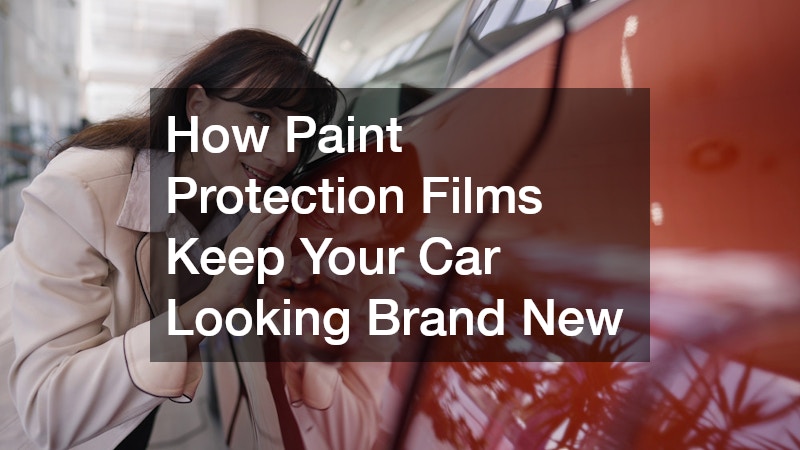
Paint protection films (PPFs) have surged in popularity among car enthusiasts and everyday drivers alike. These protective films are highly valued for their ability to preserve a vehicle’s pristine appeal and protect it from the rigors of daily wear and tear.
As car manufacturing techniques evolve, so does the need for solutions that can maintain a car’s original beauty. PPFs provide an innovative answer, combining advanced materials and technology for optimal results.
Video Source
In essence, PPFs help in extending the life of a car’s paint job by shielding it from potential damage and ensuring it looks showroom-ready for years. With their growing popularity, it becomes essential to understand what makes these films effective.
Paint protection films are transparent layers affixed to a car’s exterior to shield it from damage. They are typically made from a thermoplastic urethane material known for its durability and flexibility.
The composition of PPFs allows them to absorb minor impacts and resist abrasions, making them an ideal choice for car surfaces. In addition to urethane, newer variants may incorporate additional coatings for enhanced performance.
These films are crafted to be nearly invisible, allowing the car's color and finish to show through, while still providing a robust protective barrier. This articulation enhances both the aesthetic and functional characteristics of vehicles.
Originally developed for military applications during the Vietnam War, paint protection films were designed to protect helicopter rotor blades. Over time, this technology was adapted and refined for use in the automotive industry.
Advancements in material science have led to the development of more sophisticated PPFs, offering increased clarity and self-healing properties. Initially available only to luxury vehicles, these films are now accessible to the broader market.
The evolution of PPFs reflects a growing emphasis on preserving vehicle value and aesthetics. This technology has seen widespread adoption across the automotive world, revolutionizing how car owners protect their investments.
Paint protection films work using a combination of high-tensile strength and elasticity, providing a shield against minor abrasions and environmental factors. The self-healing properties of PPFs allow them to recover from swirl marks and light scratches with heat exposure.
The urethane material that constitutes these films possesses high impact resistance, dispersing energy from impacts to prevent surface damage. Furthermore, a clear coat finish enhances the film’s ability to repel stains and resist discoloration.
Through the integration of new innovations, some PPFs also contain hydrophobic properties, which help in repelling water and debris. This sophisticated engineering allows the film not only to protect but also to maintain the car’s surface cleanliness.
The application of paint protection films involves meticulous preparation to ensure proper adhesion and effectiveness. Initially, the car’s surface is thoroughly cleaned and decontaminated to eliminate any impurities.
Next, a pre-measured film piece is expertly laid over the desired panels. Installers use a combination of solutions and squeegees to work out any air bubbles and ensure a seamless fit.
The final step involves inspection and any necessary trimming to ensure the film aligns perfectly with the vehicle's contours. This precise installation is crucial in maximizing the durability and aesthetic of the PPFs.
PPFs provide an effective barrier against chips, scratches, and other physical abrasions that vehicles encounter daily. This protection is crucial for preserving the car’s finish in all driving environments.
Compared to conventional paint sealants, PPFs offer superior resistance to stones and debris encountered on the road. This protection ensures the vehicle’s longevity and paint integrity against the elements.
Additionally, the self-healing property of the film means minor imperfections resolve themselves over time, contributing to the car’s continued visual appeal. These features collectively serve to preserve the vehicle's aesthetics dramatically.
Investing in paint protection films can lead to significant savings over time by minimizing the need for costly paint repairs. A well-applied PPF reduces maintenance costs by protecting the underlying paint from damage.
The initial expense of a PPF application is quickly offset by the reduced frequency of paint correction and touch-ups. This ultimately enhances the resale value of the vehicle, providing a sound economic argument for its adoption.
Prospective buyers often prioritize vehicles that have been meticulously maintained, giving sellers of PPF-protected cars a competitive edge. This preservation of the vehicle’s paint quality also indirectly contributes to its perceived and actual market value.
Paint protection films offer a comprehensive solution for vehicle owners desiring to maintain a flawless car exterior. From safeguarding against physical damage to offering long-term cost-efficiency, PPFs deliver multiple benefits.
The integration of advanced technology in PPFs signifies their pivotal role in modern automotive care. As awareness and accessibility continue to grow, paint protection films are becoming an indispensable tool for maintaining automotive investments.
Ultimately, PPFs not only preserve a vehicle’s appearance but also ensure it retains its value and attractiveness in the years to come. For car owners seeking a reliable and effective method to uphold their vehicle’s aesthetics, PPFs stand out as the definitive choice.
